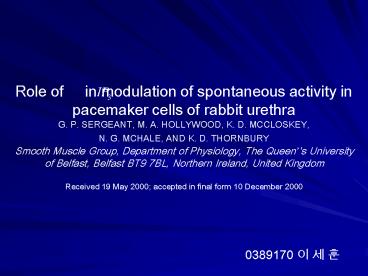Role of in modulation of spontaneous activity in - PowerPoint PPT Presentation
1 / 17
Title:
Role of in modulation of spontaneous activity in
Description:
Smooth Muscle Group, Department of Physiology, The Queen''s University ... Fast STOCs bore no obvious relationship to STICs. Slow STOCs were usually coupled to STICs ... – PowerPoint PPT presentation
Number of Views:35
Avg rating:3.0/5.0
Title: Role of in modulation of spontaneous activity in
1
Role of in modulation of spontaneous activity
in pacemaker cells of rabbit urethra G. P.
SERGEANT, M. A. HOLLYWOOD, K. D. MCCLOSKEY, N.
G. MCHALE, AND K. D. THORNBURY Smooth Muscle
Group, Department of Physiology, The Queen's
University of Belfast, Belfast BT9 7BL, Northern
Ireland, United Kingdom Received 19 May 2000
accepted in final form 10 December 2000
0389170 ? ? ?
2
Introduction
- Interstitial cell(Pacemaker cell) from rabbit
urethra - Under voltage clamped -60mV, there are inward and
outward currents (STIC, STOC). - These current were abolished by some factors.
- cyclopiazonic acid(CPA), caffeine, or ryanodine,
suggesting that they were activated by
release. - D-myo-inositol 1,4,5-trisphosphate (
)-sensitive stores were blocked with
2-aminoethoxydiphenyl borate
3
Introduction
- fast STOCs are mediated by a mechanism similar to
STOCs in smooth muscle, STICs and slow STOCs are
driven by IP3 - The currents (spontaneous transient inward
currents, STICs), which underlie the STDs, are
believed to result from activation of
-dependent
channels by released from intracellular
stores (9, 10, 21). - The only way to resolve this issue would be to
study the mechanisms underlying STICs and STOCs
in the pacemaker cells themselves, where it is
conceivable that the -activated and
channels are activated by different mechanisms.
4
Methods
- Bladder and urethra were removed from both male
and female rabbits immediately after they had
been killed by lethal injection of
pentobarbitone. - The most proximal 1 cm of the urethra was removed
and placed in Krebs solution, and from this,
strips were dissected for cell dispersal.
5
Results
- A potent blocker of large conductance
-activated channels (BK channels) - STICs had a duration in the order of seconds,
while the STOCs fell into two broad types (fast
STOC, slow STOC)
6
Results
- Fast STOCs bore no obvious relationship to STICs
- Slow STOCs were usually coupled to STICs
- Because of that, analyzing their time course
accurately at this potential is difficult.
7
Results
- The effect of caffeine (10 mM) was to completely
- block STOCs
STOCs from a cell held at 0 mV
- Caffeine initially evoked a transient outward
current after which STOCs were suppressed. - After washout the drug, it returned.
8
Results
- These results are consistent with an effect of
caffeine dumping intracellular stores. - The stores are essential for firing STICs and
STOCs. - Ryanodine abolished STICs, fast STOCs and slow
STOCs.
9
Results
- 30uM ryanodine abolished STICs within 5min in a
cell held at -60mV.
10
Results
- 30uM ryanodine abolished fast STOCs within 5min
in a cell held at 0mV.
11
Results
- 30uM ryanodine abolished slow STOCs in a
different cell under similar condition.
12
Results
- 10uM cyclopiazonic acid (CPA) abolished STICs at
-60mV potential.
13
Results
- fast STOCs were also reversibly abolished by
10uM CPA.
14
Results
- The effect of 2APB(2-aminoethoxydiaphenyl
borate) on norephinephrine-evoked currents.
15
Results
- Caffeine-evoked currents.
16
Discussion
- IP3 binding or IP3 production action seemed to
be specific as it failed to block
caffeine-induced release from cardiac and
skeletal sarcoplasmic reticulum vesicles. - It had no effect on caffeine response, although
it blocked norepinephrine-induced currents - IP3-dependent waves initiate the STICs and
slow the STOCs in these cells.
17
Discussion
- These ideas must remain speculative until
further studies characterize the events that
underlie STICs and STOCs in these cells and until
the anatomical relationship among the
channels, the BK channels, and the stores is
defined.































